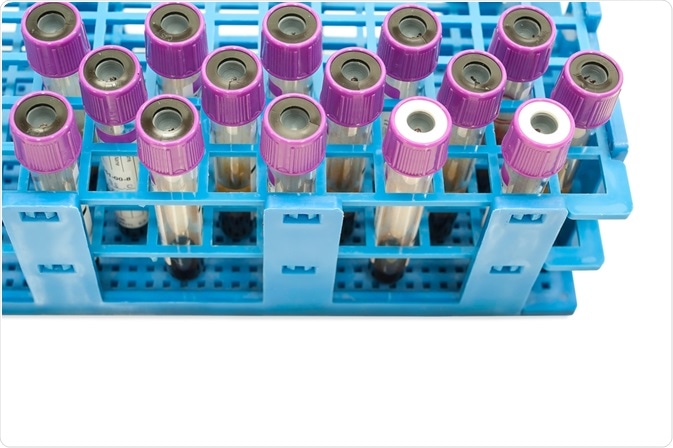Researchers from the University of Freiburg, Germany have developed a functional flow cytometry-based method for the diagnosis of innate primary immunodeficiencies (PIDs). The technique was applied to monocytes, the model leukocyte of the innate immune system.
 Image Credits: Chansom Pantip / Shutterstock.com
Image Credits: Chansom Pantip / Shutterstock.com
The test is instrumental as it can provide functional information i.e. cytokine expression and signaling pathway activation as well as indicating the presence or absence of the immune cells themselves in a timely manner that informs clinical decision making.
Functional monocyte flow cytometry offers an alternative to diagnosing innate primary immunodeficiencies using assays that determine the concentration of cytokines on ELISAs or viral titer; these do not offer a means of controlling for the number of responsive cells in each sample. This is especially useful for patients who have variants of uncertain significance (VUS).
VUS are variant forms of a gene that have been identified through genetic testing, with an undetermined effect on the health of the organism. In the absence of validated functional assays for innate immune defects, flow cytometry is a valuable tool.
The team adapted current standard experimental monocyte flow cytometry for the purposes of validating their application in workflows that are used to diagnose innate primary immunodeficiencies. To do so, the team diagnosed patient samples with patients displaying a range of deficiencies. Firstly, for patients with defects in the toll-like receptor and NOD2 signaling pathways.
The team performed an assay that measured TNF production. Typically, patients with this condition demonstrate reduced TNF production in response to stimulation by lipopolysaccharide (LPS) and L18-MDP. MDP is a synthetic derivative of muramyl dipeptide, which is a peptidoglycan constituent of both Gram-positive and Gram-negative bacteria and can elicit an inflammatory response.
The team also used this assay in patients with early-onset inflammatory bowel disease or with suspected X-linked inhibitor of apoptosis (XIAP) deficiency.
To diagnose a deficiency in an impaired response to IL-10, the team adapted the assay by preincubating the sample with IL-10; this prevents the production of TNF typically induced by LPS. Finally, to identify patients with defects in type I interferon signaling pathway defects the team used a flow-cytometry based assay.
This involved the incubation of peripheral blood mononuclear cells (PMBCs) with increasing IFN-a concentrations. After this, cells were resuspended in a medium containing recombinant vesicular stomatitis virus (VSV) that were engineered to express a green fluorescent protein (GFP), generating VSV-GFP.
In response to IFN-a stimulation, the fraction of PMBCs that stained for GFP was taken as a measure of type I interferon activity. A sustained a stable reduction in the number of GFP-positive cells to less than 20% was taken as confirmation of healthy donors with no immunodeficiencies.
To diagnose patients with an impaired response to IL-10, the team pre-incubated cells with the cytokine at increasing concentration. A reduction in TNF production was measured. They perform the same essay in patients with early-onset inflammatory bowel disease. The results were validated using genetic sequences for mutations in the genes controlling for the IL-10 receptors.
The team also performed three monocyte flow cytometric assays which produced reproducible results indicating that patients suffered from loss of function mutations in mediators of immune signaling on the surfaces of cells.
These results were corroborated using the IL-10 inhibition assay, the IFN-a assay which detects IFN-a/b receptor deficiency and the L18-MDP assay which reveals a deficiency in the ubiquitin chain assembly complex and receptor-interacting serine/threonine kinase 2. However, these tests require validation, and so functional tests that determine the integrity of the immune signaling pathways offer several advantages.
Firstly, they can return results between 24-48 hours, which is pertinent for healthcare professionals that must make treatment decisions. Secondly, the results obtained are functional, unlike in the case of VUS whose functional effects require confirmation.
Thirdly, functional tests can query the whole of the signaling pathway and are able to include molecules that are not typically included in the repertoire of proteins taken to be indicative of an innate primary immunodeficiency. As such, they are not excluded; typically, whole-exome sequencing and candidate gene analysis will miss these molecules.
Finally, the cost of functional analysis as offered by flow cytometry is often lower as the cost of personnel and data processing. Elling et al. note that the disadvantage of these functional results is their reliance on genetic confirmation (as opposed to functional), but this reliance is easier when functional flow cytometry is performed as part of a diagnosis pathway.
In conclusion, the assays that are presented by the group offer robustness and reliability that ensure that clinical decisions made can be done so based on functional results.
Source
Amman S. et al. (2020) Functional flow cytometry of monocytes for routine diagnosis of innate primary immunodeficiencies. J Allergy Clin Immunol. DOI: 10.1016/j.jaci.2019.09.002.
Further Reading
Last Updated: Mar 12, 2020